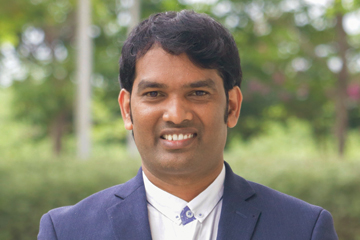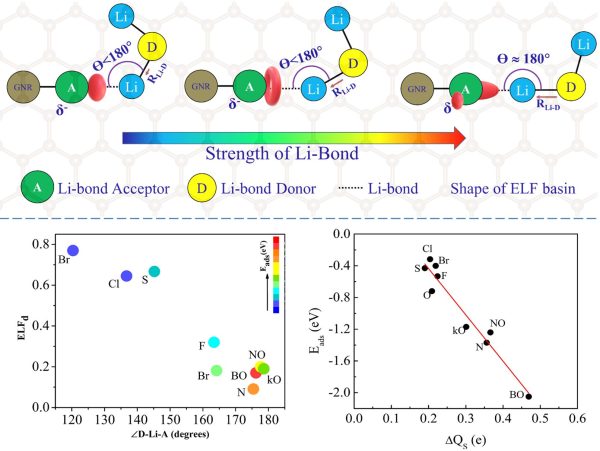Dr Satheesh Ellipilli joins us as a Ramanujan Fellowship Faculty
 SRM University-AP is honoured to host Dr Satheesh Ellipilli as a DST- Ramanujan Fellowship Faculty and facilitate his research for the next five years.
SRM University-AP is honoured to host Dr Satheesh Ellipilli as a DST- Ramanujan Fellowship Faculty and facilitate his research for the next five years.
Ramanujan Fellowship is one of the most prestigious scientific fellowships that is offered to the Indian scientists working abroad. This fellowship is offered by Science and Engineering Research Board (SERB) to encourage scientists of Indian origin to return and research in an Indian institute/University.
SERB offers the scientists Rs 1,35,000/- per month along with research grant of Rs 7,00,000/- per annum and Rs 60,000/- per annum for overhead charges.
Dr. Satheesh Ellipilli obtained his PhD from Indian Institute of Science Education and Research, Pune. He worked as a postdoctoral researcher in The Ohio State University (Columbus, USA), Emory University (Atlanta, USA), and The University of Utah (Salt Lake City, USA).
Dr. Satheesh Ellipilli has extensive experience in the field of nucleic acid chemistry, particularly, focusing on utilization of RNA nanotechnology for cancer therapy using RNAi therapeutics in combination with small molecule drugs.
He has made numerous publications in some of the most renowned journals like Journal of Organic Chemistry, Journal of Controlled Release, Chemical Communications, Bioconjugate Chemistry, Organic and Biomolecular Chemistry, and Chemical Review to name a few.
Having Dr Ellipilli with us for the duration of his fellowship is a golden learning opportunity and a pleasure to be the host institution for his work. We hope that our students and scholars develop stronger research ethics and acumen in his company.
- Published in Chemistry-news, Departmental News, News
Assessment of corporate bodies in the light of corporate governance rating
![]() Assessing the grading and rating system in any corporation is important for the management and the stakeholders, and the more efficient they are the easier it becomes to plan future trajectories. SRM University-AP is happy to announce that Dr Lakshman Rao Ayyagari, Assistant Professor of Commerce has researched extensively on this issue and published a paper titled, “The ignored tool “corporate governance rating”: An overview of the corporate world in the emerging market” in “Journal of Governance and Regulation.
Assessing the grading and rating system in any corporation is important for the management and the stakeholders, and the more efficient they are the easier it becomes to plan future trajectories. SRM University-AP is happy to announce that Dr Lakshman Rao Ayyagari, Assistant Professor of Commerce has researched extensively on this issue and published a paper titled, “The ignored tool “corporate governance rating”: An overview of the corporate world in the emerging market” in “Journal of Governance and Regulation.
According to Dr Ayyagari, this research work is like a grading pattern, we adopt to rate and rank various organizations on various parameters, accordingly “Corporate Governance Rating” is a tool to assess firms’ performance, but not widely used in assessment, recommended for its use, keeping in mind the interests of various stakeholders.
About the research:
The interest of the Stakeholders is to see the growth of their entities, also they benchmark their entities through business performance metrics or tools like Return on Equity, Return on Assets, Earnings Per Share, Gross Profit Margin, Employee Productivity, Sales Turnover, ratings given by prominent credit rating agencies such as ICRA, CRISIL, Standard and Poor etc. In addition to this, internal governance mechanisms, board of directors’ characteristics, their independence, transparency, concentration, and presence of employees in the ownership structure also influence financial and stock market performance. However, assessing the performance of entities through some of these limited angles is not always possible. One more criterion for assessing the performance of entities is “Corporate Governance Rating”. However, it is not widely used as a tool to assess a firm’s performance in the emerging markets. The present research paper is intended to address the scenario of Corporate Governance Rating in the Corporate World to assess a firm’s performance. With the help of majorly secondary sources of data conducted a study from 2003 to 2021 based on the CRISIL’s rating pattern. The findings showed the significance of Corporate Governance Rating for its adoption and future research in the development of rating mechanisms in India as well as in emerging markets.
This research can be recommended to regulatory bodies especially in India like SEBI for conducting thorough research in this area for a policy study and implementation.
- Published in News, Research News
Stabilizing Li-S batteries: energy storage solution for the future
 As technology gets revolutionized, we face the need to have more- more efficient energy storage solutions with decreased strain on the environment to meet our need. SRM University-AP happy to let everyone know that our Dr Ranjit Thapa, Professor of Physics along with his PhD scholar, Mr Deepak S Gavali has published a paper titled, “Understanding the role of lithium bonds in doped graphene nanoribbons as cathode hosts for Li-S batteries: A first-principles study” in ‘International Journal of Energy Research’, having an Impact Factor of 5.164.
As technology gets revolutionized, we face the need to have more- more efficient energy storage solutions with decreased strain on the environment to meet our need. SRM University-AP happy to let everyone know that our Dr Ranjit Thapa, Professor of Physics along with his PhD scholar, Mr Deepak S Gavali has published a paper titled, “Understanding the role of lithium bonds in doped graphene nanoribbons as cathode hosts for Li-S batteries: A first-principles study” in ‘International Journal of Energy Research’, having an Impact Factor of 5.164.
About the Research:
Lithium sulphur (Li-S) batteries hold immense potential as energy storage devices of the future because of their high energy density (2600 Wh kg −1), lower cost and non-toxic nature as compared to the currently available lithium-ion batteries. However, the commercialization of Li-S batteries is hindered due to a number of challenges that include the polysulfide shuttle effect, viz, the dissolution of lithium polysulfide species (LiPS) in the cathode into the electrolyte and its diffusion to the anode and back. The shuttle effect results in poor Coulombic efficiency, low utilization of active materials, and degradation of electrode. Moreover, the insulating nature of the sulphur cathode is a key contributor to its low specific capacity. One way to circumvent these problems is by employing conducting cathode hosts as additives that would act as trapping agents for the LiPS, preventing their migration to the anode.
“Using first-principles calculations, we investigate a family of doped graphene nanoribbons (GNRs) for their suitability as cathode hosts in Lithium sulphur batteries. We probe the role played by the lone pairs of the dopants in confining the Lithium polysulfides (LiPS) in order to understand the mechanism of binding. Our results show that the Li-bond between the polysulfides and the doped GNRs is analogous to a hydrogen bond and also dipole-dipole interactions play a key role in anchoring the polysulfides. The charge lost by the sulphur atom of the polysulfide upon adsorption and shape of the lone pair basins and the value of ELF at the dopant position can provide a quick estimate of the strength of the bond. Significant contractions in the ELF profiles are also observed upon Li 2 S adsorption, further providing evidence for the H bond like nature of the Li-bond. Our results corroborate the fact that all acceptors suitable for hydrogen bond can be employed as suitable dopants for carbon-based cathode hosts in Li-S batteries.”
Dr Thapa and his PhD scholar conducted this research in collaboration with a Department of Physics and Research Centre, Lady Doak College, Madurai, 625002, Tamil Nadu, India. For their future research they are also working in the field of Li-ion battery. They are searching for new carbon allotrope structure which should have the ability to enhance the specific capacity and reduce the volume expansions as compared to the commercialized anode material.
- Published in News, Research News
Obtaining encrypted images with new Reversible Data Hiding scheme
 SRM University-AP is pleased to announce that Dr V M Manikandan, Assistant Professor in the Department of Computer Science and Engineering, along with his research scholar Shaiju Panchikkil, published a paper titled, “A convolutional neural network model based reversible data hiding scheme in encrypted images with block-wise Arnold transform” in Optik Journal, Elsevier Publications.
SRM University-AP is pleased to announce that Dr V M Manikandan, Assistant Professor in the Department of Computer Science and Engineering, along with his research scholar Shaiju Panchikkil, published a paper titled, “A convolutional neural network model based reversible data hiding scheme in encrypted images with block-wise Arnold transform” in Optik Journal, Elsevier Publications.
The proposed scheme can be used for embedding electronic patient reports (EPR) in the medical image itself while transmitting, and at the receiver side the reports can be extracted along with the lossless recovery of the medical images.
About the Research:
Data hiding or information hiding is a well-explored way to secure some secret data by concealing it in a digital cover medium. The reversible data hiding (RDH) is a recent advancement in the field of data hiding in which the cover medium can be restored during the extraction of hidden messages at the receiver side. The RDH schemes are widely used in medical image transmission and cloud computing. Recently, research in the field of RDH in encrypted images got much attention to improve the efficiency parameters such as embedding rate and bit error rate without compromising the lossless recovery of the images. In this research paper, we propose a new RDH scheme in encrypted images which utilizes the Arnold scrambling technique for data hiding. A convolutional neural network (CNN) model is trained and used to extract the hidden message along with the recovery of the original image. The experimental study and result analysis of the proposed scheme are carried out on the USC-SIPI image dataset managed by the University of Southern California.
Dr Manikandan collaborated with Prof. Yu-Dong Zhang, Professor in School of Computing and Mathematical Sciences, University of Leicester, UK collaborated for this research work. In the future, Dr Manikandan’s research will be more focussed on coming up with new reversible data hiding schemes in encrypted images with better embedding rate and bit error.
- Published in CSE NEWS, Departmental News, News, Research News

